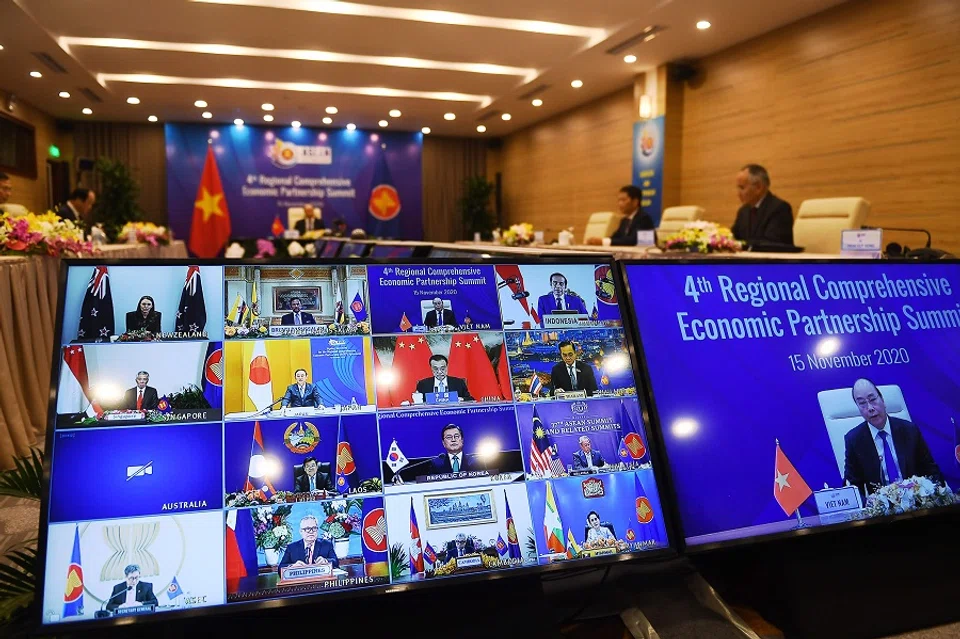The overstatement of the RCEP
Chinese netizens and commentators have largely celebrated the RCEP as being China-led and a coup for China. Zhu Ying provides a reality check as to why the Chinese should instead have their feet firmly on the ground.

It is indeed extraordinary that the Regional Comprehensive Economic Partnership (RCEP) was signed amid the current wave of trade protectionism. However, the way that the agreement has been talked up is not in keeping with the practice of "seeking truth from facts". Thus, I am here to set straight the overstatement of the RCEP.
Firstly, the RCEP is an ASEAN-led initiative. ASEAN countries proposed the idea of establishing an RCEP in 2011. This idea was formally approved by the leaders of ASEAN's ten member states during the ASEAN Summit that same year. In 2012, the leaders of ASEAN's ten member states, China, Japan, Korea, India, Australia and New Zealand, jointly released the "Joint Declaration on the Launch of Negotiations for the Regional Comprehensive Economic Partnership", marking the official launch of negotiations on a free trade agreement that would cover 16 countries. Thus, based on the starting point of the RCEP (now covering 15 countries, with the withdrawal of India last year), this initiative is clearly ASEAN-led.
Chinese patriotism blowing RCEP out of proportion
While China actively participated in and supported the negotiations of the RCEP, Chinese officials have always maintained that the RCEP is ASEAN-led. However, the rise of patriotism in China has perpetuated the thinking that the RCEP is China-led. Perhaps the Chinese who spread this belief have taken for granted that China is a big country and ASEAN member states are small countries - how can small countries lead big ones? A sentence that former Chinese Foreign Minister Yang Jiechi once said - "China is a big country and other countries are small countries, and that's just a fact" - has also been making the rounds in the media. Regardless of the context of this sentence, amid China's patriotic fervour, people are all ears. Such a superpower mentality naturally leads to the argument that the RCEP is China-led.
If China really joins the CPTPP, surely that doesn't mean we should start saying that the CPTPP is China-led?

Taking a step back, Chinese media said that regardless of whether the RCEP is China-led or not, a Japan-led Asia no longer exists. In actual fact, it was Japan that successfully salvaged the Trans-Pacific Partnership (TPP) and paved the way for the birth of the Comprehensive and Progressive Agreement for Trans-Pacific Partnership (CPTPP), which has now been in place for over a year.
The CPTPP is the first Japan-led massive regional free trade agreement. Both the RCEP and CPTPP promote free trade - one should not downplay Japan's dominant role in the CPTPP just because there is now another trade agreement that China is a part of. The competition between the Chinese and Japanese economies is not a zero-sum game. China's top leader has now expressed that China will "favourably consider" joining the CPTPP. If China really joins the CPTPP, surely that doesn't mean we should start saying that the CPTPP is China-led?
How progressive is the RCEP?
Secondly, while the RCEP's level of liberalisation is a little higher than the WTO's, it is lower than the free trade agreements that have been signed in recent years, including the CPTPP, the United States-Mexico-Canada Agreement (USMCA), and the EU-Japan Economic Partnership Agreement (EPA). In other words, the RCEP is not a "high-standard free trade agreement", let alone a "new demonstration zone".
Looking at the liberalisation of the trade in goods, the CPTPP eliminates tariffs on 99% of goods traded among its parties, versus the RCEP's 90%. In terms of trade in services, while the CPTPP, USMCA, and EPA adopt a negative list approach, the RCEP allows for a positive list approach.
China has always avoided issues pertaining to state-owned enterprises, the environment, and labour when signing free trade agreements.
In terms of financial services trade, the RCEP models after the WTO and subsumes financial services trade under trade in services. However, it is more advanced than the WTO in the sense that the Annex on Financial Services contains stipulations on new financial services, the transfer of data by electronic and other means and the processing of information, etc. In the CPTPP, financial services is a chapter on its own and independent of cross-border trade in services. Contracting parties adopt a negative list approach to fulfil liberalisation commitments when providing financial services through a commercial presence. On the other hand, a positive list approach is adopted by contracting parties in cross-border trade in financial services.

While the RCEP includes a chapter on government procurement, it is only applicable to central government entities and mainly outlines transparency obligations. The government procurement market of the RCEP is less open than the WTO's. Compared with the WTO, the CPTPP and USMCA's government procurement clauses are more rigorous in terms of scope of application, procurement method, transparency, and legitimacy. They are also more open in terms of the bidders list, reflecting the characteristics of a fairer, more internationalised and liberalised set of government procurement procedures.
In terms of trade and investment rules, the RCEP does not touch on issues pertaining to state-owned enterprises, the environment and labour. As early as 1994, environmental and labour issues had already been included in the North American Free Trade Agreement (NAFTA). At present, environmental and labour issues are a standard feature of global free trade agreements. The free trade agreements that have emerged in recent years have also formulated a set of rules for state-owned enterprises. China has always avoided issues pertaining to state-owned enterprises, the environment, and labour when signing free trade agreements.
Bilateral relations may stand in way of reaping FTA benefits
Third, FTAs do not necessarily lead to free trade. A paper by Peter A. Petri published by the Peterson Institute for International Economics earlier in the year concluded that China is well-positioned to be the biggest beneficiary of the RCEP. Petri's findings showed that China was hardest hit by the China-US trade war, with a total loss of up to US$304 billion. Not being part of the CPTPP cost China US$28 billion, while it stands to gain up to US$100 billion from the RCEP, offsetting about one-third of the impact from its trade war with the US.
But all this is just the result of plugging mathematical models into economic models - and models do not account for changes that come with the deterioration of political relations. That is to say, if relations between China and RCEP members deteriorate, can FTAs still promote trade? Are current China-Australia relations not a good example? China and Australia signed an FTA on 17 June 2015, which took effect on 20 December 2015. Now, with the RCEP as well, logically speaking trade between China and Australia should pick up in a big way.

However, given the current tense political relations between China and Australia, it is easy to understand China's measures of stopping imports, launching anti-dumping investigations, and implementing customs delays with regard to Australia-produced timber, wine, wheat, beef, lobster, and coal.
Economists do not consider politics in their analyses of free trade agreements, and so their calculations in terms of dollars and cents can only be a reference.
These moves are reminiscent of the impact of the THAAD missile controversy on China-South Korea trade (which led to South Korea's GDP shrinking by 5 trillion won), and the Lotte group pulling out of the China market. At the time, there was also an FTA between China and Korea, which shows that while FTAs can promote trade, if political relations go downhill, trade will take a hit.
Economists do not consider politics in their analyses of free trade agreements, and so their calculations in terms of dollars and cents can only be a reference. Can one conclude from the RCEP members that China has secured the largest circle of friends?
Fourth, will the RCEP really have an "immeasurable effect on China's geopolitical economy" as some say? FTAs can stimulate China's external trade and boost its hard power, but may not increase its geopolitical influence, which depends on a host of factors including values, military affairs, and diplomacy. A recent report by the RAND Corporation on the influence of China and the US in the Indo-Pacific illuminates this point very well.
China behind the US in diplomatic and military influence in Indo-Pacific
The authors conducted interviews with officials and academics in nine countries - Singapore, the Philippines, Indonesia, Malaysia, Thailand, Vietnam, Japan, Australia, and India - and found that the US had greater influence in Australia, India, Japan, the Philippines, and Singapore, while China had greater influence than the US in Malaysia, Thailand, and Vietnam; both had similar levels of influence in Indonesia.
Having them is better than not having them, but the increase in trade resulting from FTAs may not necessarily translate to soft power.

The report concluded that China has greater economic influence in the Indo-Pacific, while the US has greater diplomatic and military influence. But the countries in that region are more focused on economic development rather than security issues, and are more concerned about China's economic influence. One of the authors, Bonny Lin, was quoted in a report by Radio Free Asia as saying that the countries in that region are aware that China might exert economic pressure on them, and they are seeking ways to reduce economic dependence on China. She added that China's economic edge is only from a bilateral perspective, and if the US and its allies were to put together their resources and economic strength, these countries would have the greater economic might and influence.
The four points above should put things in perspective and set straight the overstatement of the RCEP, and would likely provide a better idea of how FTAs work. Having them is better than not having them, but the increase in trade resulting from FTAs may not necessarily translate to soft power. A German media commentator said that the RCEP members are not naively following China's will - on the contrary, there is growing resistance among Asian countries against Beijing's expanding power. The Chinese would do well to consider why such voices exist.



![[Photos] Fact versus fiction: The portrayal of WWII anti-Japanese martyrs in Taiwan](https://cassette.sphdigital.com.sg/image/thinkchina/3494f8bd481870f7c65b881fd21a3fd733f573f23232376e39c532a2c7593cbc)

